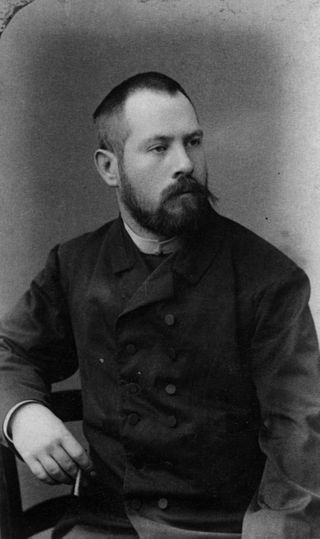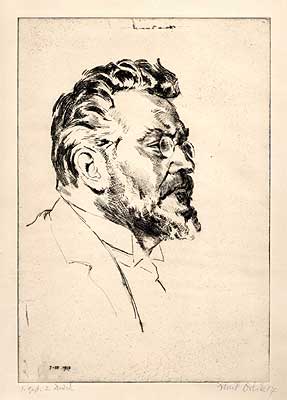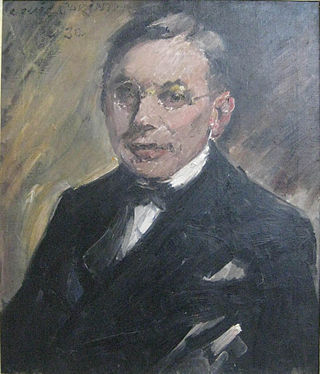
Max Liebermann was a German painter and printmaker, and one of the leading proponents of Impressionism in Germany and continental Europe. In addition to his activity as an artist, he also assembled an important collection of French Impressionist works.

Lovis Corinth was a German artist and writer whose mature work as a painter and printmaker realized a synthesis of impressionism and expressionism.

Max Slevogt was a German Impressionist painter and illustrator, best known for his landscapes. He was, together with Lovis Corinth and Max Liebermann, one of the foremost representatives in Germany of the plein air style.

The Berlin Secession was an art movement established in Germany on May 2, 1898. Formed in reaction to the Association of Berlin Artists, and the restrictions on contemporary art imposed by Kaiser Wilhelm II, 65 artists "seceded," demonstrating against the standards of academic or government-endorsed art. The movement is classified as a form of German Modernism, and came on the heels of several other secessions in Germany, including Jugendstil and the Munich Secession.

Charlotte Berend-Corinth was a German Jewish painter and artist in the Berliner Secession. She was married to German painter Lovis Corinth.

Ernst Oppler was a German Impressionist painter and etcher born in Hanover.

Boje Postel was a German-British painter.

Portrait of Mink with Violet Shawl is an oil-on-canvas portrait by German painter Max Beckmann. It depicts his first wife, the opera singer Minna Beckmann-Tube, and was executed in 1910. It is held in the collection of the Saint Louis Art Museum.

Butcher Store in Schäftlarn on the Isar is a painting by the German painter Lovis Corinth from 1897. The picture shows a scene from the store of a slaughterhouse in Schäftlarn near Munich. It is held in the Kunsthalle Bremen.

Innocence is a painting created by the German painter Lovis Corinth in 1890. The picture depicts a semi-nude female and is owned by the Städtische Galerie im Lenbachhaus, in Munich.

Susanna in the Bath is an early painting by German painter Lovis Corinth, created in 1890 in his hometown of Königsberg. Corinth painted two slightly different versions of it, the first of which he exhibited at the Salon de Paris in 1891. The initial version, believed to be lost, was rediscovered in 2006 through a private auction. The better-known second version, however, has been part of the Museum Folkwang, in Essen, since 1966.

Self-Portrait with Skeleton is an oil on canvas painting by the German painter Lovis Corinth, from 1896. It is held in the Lenbachhaus, in Munich.

Young Woman with Cats is an oil on canvas painting by the German painter Lovis Corinth, from 1904. The person portrayed is Corinth's wife, Charlotte Berend, who was 24 years old at the time. The painter's signature can be found in the upper right corner of the canvas. It is held now in the Staatsgalerie Stuttgart.

Carmencita is an oil on canvas painting by the German painter Lovis Corinth, from 1924. It belongs to his expressionist phase and it was the last portrait of his wife, Charlotte Berend-Corinth, who appears dressed as a Spanish noblewoman, after a costume party. It is held in the Städel, in Frankfurt am Main, which acquired it in 1959.

The Self-Portrait with His Wife and a Glass of Champagne in the catalog raisonné, , is a painting by the German painter Lovis Corinth. The double portrait shows himself and his painting student and later wife Charlotte Berend, who is sitting on his lap with her upper body unclothed and is being embraced by him while he raises a glass. It was created as an engagement painting in Corinth's studio in Berlin in October 1902, a few months before the marriage of the two sitters. The painting, painted in oil on canvas and measuring 98.5 × 108.5 centimetres, is privately owned.

'The Red Christ is an oil on wood painting by the German painter Lovis Corinth, from 1922. It is a depiction of the crucifixion of Jesus Christ, belonging to his expressionist phase. The painting is signed and dated in yellow in two lines on the upper left: “Lovis Corinth 1922 ”. It is held in the Pinakothek der Moderne, in Munich.

The Portrait of the Artist's Uncle, Friedrich Corinth is a oil painting by the German painter Lovis Corinth. It is executed in portrait format on canvas and measures 98 × 79 centimeters. The portrait of his Ohm was created in 1900 during a visit by the artist to his uncle in Moterau in East Prussia. It was owned by the Corinth family until 1987, most recently by Wilhelmine Corinth in New York City. It was then purchased by the German federal government for the newly founded Ostpreußisches Landesmuseum, in Lüneburg, in whose collection it remains.

Max Treitel was a German painter.

Country House in Hilversum is an oil on canvas painting by the German painter Max Liebermann, from 1901. The painting shows a villa in a park near the Dutch town of Hilversum. It is signed "M.Liebermann" at the bottom left. It is part of the collection of the Alte Nationalgalerie, in Berlin.

Othello, also known as Sailor, is an oil on canvas painting by the German painter Lovis Corinth, from 1884. It is a bust portrait of a black man who was a dock worker or sailor from the port of Antwerp, Belgium. The artist himself signed the painting in the upper left and titled it in the upper right with the words: "Un Othello". It was in the Lentos Art Museum, in Linz, since 1953, until when it was restituted to the family of his former owners, and later auctioned, in 2015. It is now in a private collection.




















